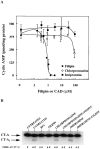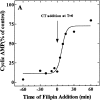Filipin-dependent inhibition of cholera toxin: evidence for toxin internalization and activation through caveolae-like domains
- PMID: 9585410
- PMCID: PMC2132770
- DOI: 10.1083/jcb.141.4.905
Filipin-dependent inhibition of cholera toxin: evidence for toxin internalization and activation through caveolae-like domains
Abstract
The mechanism by which cholera toxin (CT) is internalized from the plasma membrane before its intracellular reduction and subsequent activation of adenylyl cyclase is not well understood. Ganglioside GM1, the receptor for CT, is predominantly clustered in detergent-insoluble glycolipid rafts and in caveolae, noncoated, cholesterol-rich invaginations on the plasma membrane. In this study, we used filipin, a sterol-binding agent that disrupts caveolae and caveolae-like structures, to explore their role in the internalization and activation of CT in CaCo-2 human intestinal epithelial cells. When toxin internalization was quantified, only 33% of surface-bound toxin was internalized by filipin-treated cells within 1 h compared with 79% in untreated cells. However, CT activation as determined by its reduction to form the A1 peptide and CT activity as measured by cyclic AMP accumulation were inhibited in filipin-treated cells. Another sterol-binding agent, 2-hydroxy-beta-cyclodextrin, gave comparable results. The cationic amphiphilic drug chlorpromazine, an inhibitor of clathrin-dependent, receptor-mediated endocytosis, however, affected neither CT internalization, activation, nor activity in contrast to its inhibitory effects on diphtheria toxin cytotoxicity. As filipin did not inhibit the latter, the two drugs appeared to distinguish between caveolae- and coated pit-mediated processes. In addition to its effects in CaCo-2 cells that express low levels of caveolin, filipin also inhibited CT activity in human epidermoid carcinoma A431 and Jurkat T lymphoma cells that are, respectively, rich in or lack caveolin. Thus, filipin inhibition correlated more closely with alterations in the biochemical characteristics of CT-bound membranes due to the interactions of filipin with cholesterol rather than with the expressed levels of caveolin and caveolar structure. Our results indicated that the internalization and activation of CT was dependent on and mediated through cholesterol- and glycolipid-rich microdomains at the plasma membrane rather than through a specific morphological structure and that these glycolipid microdomains have the necessary components required to mediate endocytosis.
Figures











Similar articles
-
Brefeldin A blocks the response of cultured cells to cholera toxin. Implications for intracellular trafficking in toxin action.J Biol Chem. 1993 Jun 5;268(16):12010-6. J Biol Chem. 1993. PMID: 8389369
-
Ganglioside structure dictates signal transduction by cholera toxin and association with caveolae-like membrane domains in polarized epithelia.J Cell Biol. 1998 May 18;141(4):917-27. doi: 10.1083/jcb.141.4.917. J Cell Biol. 1998. PMID: 9585411 Free PMC article.
-
Internalization of cholera toxin by different endocytic mechanisms.J Cell Sci. 2001 Oct;114(Pt 20):3737-47. doi: 10.1242/jcs.114.20.3737. J Cell Sci. 2001. PMID: 11707525
-
Floating cholera toxin into epithelial cells: functional association with caveolae-like detergent-insoluble membrane microdomains.Int J Med Microbiol. 2000 Oct;290(4-5):403-8. doi: 10.1016/S1438-4221(00)80052-1. Int J Med Microbiol. 2000. PMID: 11111918 Review.
-
Caveolae--an alternative endocytotic pathway for targeted drug delivery.Crit Rev Ther Drug Carrier Syst. 2004;21(2):67-95. doi: 10.1615/critrevtherdrugcarriersyst.v21.i2.10. Crit Rev Ther Drug Carrier Syst. 2004. PMID: 15202927 Review.
Cited by
-
Excretory/secretory products of the carcinogenic liver fluke are endocytosed by human cholangiocytes and drive cell proliferation and IL6 production.Int J Parasitol. 2015 Oct;45(12):773-81. doi: 10.1016/j.ijpara.2015.06.001. Epub 2015 Jul 14. Int J Parasitol. 2015. PMID: 26187786 Free PMC article.
-
Visualizing HIF-1α mRNA in a Subpopulation of Bone Marrow-Derived Cells to Predict Retinal Neovascularization.ACS Chem Biol. 2020 Nov 20;15(11):3004-3012. doi: 10.1021/acschembio.0c00662. Epub 2020 Oct 20. ACS Chem Biol. 2020. PMID: 33080135 Free PMC article.
-
Nanoconjugation modulates the trafficking and mechanism of antibody induced receptor endocytosis.Proc Natl Acad Sci U S A. 2010 Aug 17;107(33):14541-6. doi: 10.1073/pnas.1006507107. Epub 2010 Aug 2. Proc Natl Acad Sci U S A. 2010. PMID: 20679244 Free PMC article.
-
The chemokine receptor CCR2 mediates the binding and internalization of monocyte chemoattractant protein-1 along brain microvessels.J Neurosci. 2001 Dec 1;21(23):9214-23. doi: 10.1523/JNEUROSCI.21-23-09214.2001. J Neurosci. 2001. PMID: 11717355 Free PMC article.
-
Hijacking the endocytic machinery by microbial pathogens.Protoplasma. 2010 Aug;244(1-4):75-90. doi: 10.1007/s00709-010-0164-2. Epub 2010 Jun 25. Protoplasma. 2010. PMID: 20574860 Review.
References
-
- Anderson RGW, Kamen BA, Rothberg KG, Lacey SW. Potocytosis: sequestration and transport of small molecules by caveolae. Science. 1992;255:410–411. - PubMed
-
- Beaumelle B, Bensammar L, Bienvenüe A. Selective translocation of the A chain of diphtheria toxin across the membrane of purified endosomes. J Biol Chem. 1992;267:11525–11531. - PubMed
-
- Brown DA, Rose JK. Sorting of GPI-anchored proteins to glycolipid-enriched membrane subdomains during transport to the apical surface. Cell. 1992;68:533–544. - PubMed
MeSH terms
Substances
LinkOut - more resources
Full Text Sources
Other Literature Sources
Research Materials

